Figure Behind Drapes #1
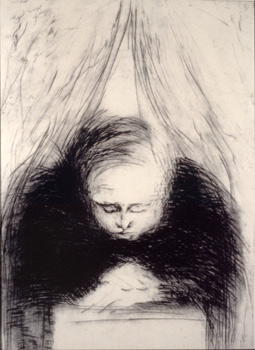
Veils Suite: Figure Behind Drapes #1
drypoint 76 x 56.5 cm.

Veils Suite: Figure Behind Drapes #1
drypoint 76 x 56.5 cm.
February 25, 2005 in Printworks, Veils Suite Comments Off on Figure Behind Drapes #1
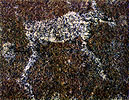
Are you a bookmarker like me? When I come across some interesting web sites that I don’t have time to read in depth at that moment, I’ll save it into a temp folder. The list gets rather long, so now and then I go through a few of them. Some get saved into properly named folders, some discarded, and some are great to share, like this one – Becoming Human: Paleoanthropology, Evolution and Human Origins. It’s a very well done interactive flash documentary that tells the story of our origins. There is even a section on Culture about our ancestors’ great creativity, their rock paintings, engravings and sculpture.
So get a cup of tea, a comfortable chair, turn up the volume and enjoy! (or bookmark it for future reading, like me!) And sorry, I don’t remember where I found it but thanks to whomever shared it, perhaps another bookmarker.
February 23, 2005 in Anthropology, History, Rock Art & Archaeology 3 Comments »
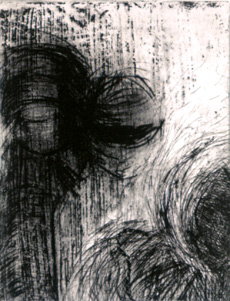
Veils Suite: Study IV
etching & drypoint 56.5 x 38 cm.
February 22, 2005 in Printworks, Veils Suite Comments Off on Study IV
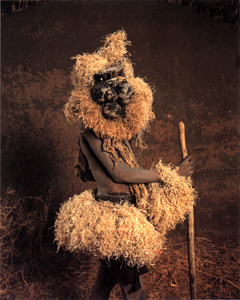
Douglas Curran, Ndapita ku Maliro (Nkhuku Mutsekele)
I’m going to the Funeral, Lock up the Chicken
(scanned from invitation)
Another very interesting and very worthwhile exhibition we went to see on Sunday afternoon (yesterday) after the visit to the Burnaby Art Gallery, was at Presentation House Gallery in North Vancouver. It is the largest non-profit photographic gallery in Western Canada, widely recognized for its exhibitions of photography and media art, emphasizing contemporary Canadian work within a context of historical and international art.
I’m not usually a huge fan of photography and film exhibitions, but my personal interest in anthropology and “primitive” cultures was piqued so I really wanted to see this one:
DOUGLAS CURRAN The Elephant Has Four Hearts: Nyau Masks and Ritual
Vancouver based photographer Douglas Curran first met members of the Chewa people while working on a film in Zimbabwe in 1992. The Chewa he met were migrant workers from Malawi employed on plantations and in mines. Over a period of several years he gradually became integrated into this community in Malawi, photographing and filming their extraordinary rituals associated with a belief system known as Nyau. The Chewa rituals and their masks are part of a complex and spectacular set of beliefs that Curran has been encouraged by the Chewa to document. Curran, no longer an outsider to this culture, has created a stunning pictorial record that invites dialogue about recording the lives of others, and forces comparisons with contemporary performance art. (from Gallery statement, curated by Bill Jeffries)
This stunning exhibition consists of 60 large colour photographs, about 10 masks and a video of village perfomances using the masks. To me, it felt like walking into the pages of National Geographic magazine or its films. They would be at home at the Museum of Anthropology at UBC as a vivid documentary of a threatened culture.
I suggest a browse through Douglas Curran’s excellent website to see some of the photos, read the catalogue and a review about the Nyau, plus his many other projects. Also read ‘Nyau Photos Challenge Cultural Appropriation’, a review by art critic Robin Laurence in the Straight.
The exhibition continues to February 27th, at Presentation House Gallery, 333 Chesterfield Avenue, North Vancouver, BC
February 21, 2005 in Anthropology, Art Exhibitions, Other artists, Photography 3 Comments »
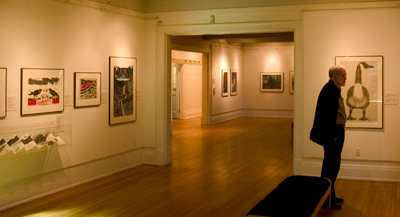
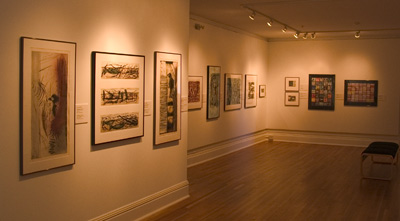
Today we finally made it out to see the touring exhibition ‘The Power of Place – 30 Years of Printmaking in Newfoundland’ at the Burnaby Art Gallery.
Some weeks ago I wrote about this in some detail – if you missed it, please read that post for the background information.
This collection of prints from St. Michael’s Printshop appeared very strong and well presented, with each artist represented by several pieces to reveal their unique visions and a variety of techniques, mostly lithographs, etchings, and relief. Each piece had something to say to me, but some of my favourites, in no particular order, were Jerry Evans’ lithograph ‘Guide and Protector of All the Children’, Anne Meredith Barry’s accordion-fold book ‘Shallow Bay Beach Walk’, Helen Gregory’s exquisite little mezzotint ‘Plundered’, Sylvia Benzsa’s collagraph ‘Rock Facing’, Sharon Puddester’s drypoints, William Ritchie’s beautifully drawn lithographs of birds and fish with hidden human features, Heidi Oberheide’s mysterious ‘Self Portrait’, and, most associated with Newfoundland seem to be Don Wright’s images of fishermens’ lives.
(To see some examples of the artists’ works online, though not always the same as in this exhibition, check out the links in my earlier article.)
I noticed an absence of “newer” computer-based processes and outsized works, which probably reflected the small space at St. Michael’s. Later, skimming through the exhibition catalogue written by curator Patricia Grattan, I read about this printshop’s dedicated focus on printmaking, but also the challenges it now faces: at a time when many printmakers elsewhere have abandoned traditional print media and editioning in favour of computer-based processes and the “one-off” incorporation of print elements into multi-media works […]SMP’s challenge will be to find its “niche market”.[…] The Printshop has continued to nourish the work and development of hundreds of artists from Canada and other countires/ But its most significant contributions have been to the development of artists in Newfoundland and to awareness of Newfoundland art beyond provincial boundaries.
The exhibition continues until Feb. 27th, don’t miss it! It will be next in Halifax in September and in Winnipeg spring 2006.
Additional reading: Article in Burnaby Now
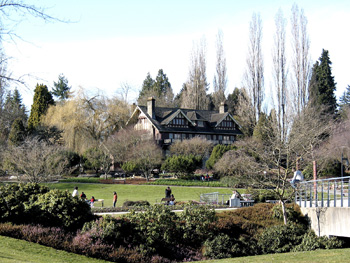
Going to the Burnaby Art Gallery is a treat, as I love this beautiful old building, full of character and history, and set amongst lovely gardens of almost ready to bloom rhododendrons and spring bulbs. Today’s warm sunshine sparkling over Deer Lake beckoned us down to the lakeshore trail for a walk and to check out the local waterfowl, including the fat and noisy Canada geese.
February 20, 2005 in Art Exhibitions, Other artists, Printmaking Comments Off on Prints from St. Michael’s Printshop
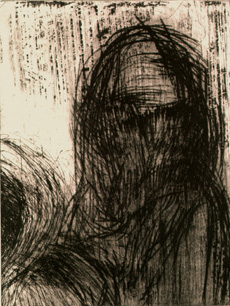
Veils Suite: Study III
etching & drypoint 56.5 x 38 cm.
February 19, 2005 in Printworks, Veils Suite 1 Comment »
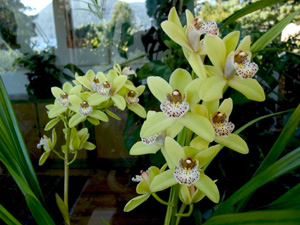
“The giraffe, in their queer, inimitable, vegetative gracefulness…a family of rare, long-stemmed, speckled gigantic flowers slowly advancing.” – Isak Dinesen (Karen Blixen), Out of Africa
I had some fun with the digital camera in my indoor garden yesterday, and now I play with words in a state of insomnia…
February 18, 2005 in Being an Artist, Photography Comments Off on orchid in bloom
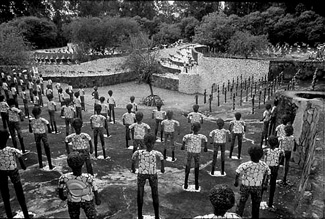
Here’s a new kind of rock art! wood s lot has pointed to Carl Lindquist’s excellent photographs and essay on Nek Chand’s Rock Garden of Chandigarh. These are captivating, go look!
One day over 40 years ago, Nek Chand, a humble transport official in the north Indian city of Chandigarh, began to clear a little patch of jungle to make himself a small garden area.[…] Now over twenty five acres of several thousand sculptures set in large mosaic courtyards linked by walled paths and deep gorges, Nek Chand’s creation also combines huge buildings with a series of interlinking waterfalls. The Rock Garden is now acknowledged as one of the modern wonders of the world. Over 5000 visitors each day, some 12 million people so far, walk around this vast creation – the greatest artistic achievement seen in India since the Taj Mahal.
Read more about Nek Chand’s massive project.
Carl Lindquist writes that Chandigarh is a modern city, built in the 1950s from a design by the French architect Le Corbusier.[…] Built of industrial waste and thrown-away items, it [the rock garden] is perhaps the world’s most poignant and salient statement of the possibility of finding beauty in the unexpected and accidental. It expresses the fragility of the environment, the need for conservation of the earth’s natural resources, the importance of balancing industrial development and sound environmental practices. It attests to the ingenuity and imagination of the people of Chandigarh and their awareness of these global concerns. Above all, it is a community’s testament of appreciation for art, expressing ideas and problems in a universal language.
February 17, 2005 in Modern Rock Art, Other artists 1 Comment »
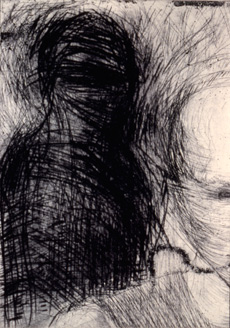
Veils Suite: Study II
etching & drypoint 56.5 x 38 cm.
February 15, 2005 in Printworks, Veils Suite Comments Off on Study II
Anna passed this to me, and while I have a vague idea of what a meme is, I’ve never done one. These questions are very challenging and time-consuming to answer and how can I limit myself?! I’m to pass it on – who would like to pick this up?
1. TOTAL AMOUNT OF MUSIC FILES ON YOUR COMPUTER: over 800 (not 100 as I wrote before!), actually on the iTunes on my husband’s computer. We share the same tastes so he looks after downloading the music off our CD collection. We enjoy falling asleep and waking up to the music from our iPod through inMotion speakers. These come along on trips too.
2. THE LAST CD YOU BOUGHT WAS: Pálgáh, by Sámi singer Aune Kuuva
3. WHAT IS THE SONG YOU LAST LISTENED TO BEFORE READING THIS MESSAGE? I don’t remember, because I wasn’t listening to music just then. The last songs I fell asleep to last night were either from our very favourite Operamania collection of 5 CDs of the some of the best operatic songs by the best singers, or maybe Thomas Hampson’s Des Knaben Wunderhorn, wonderful German lieder, like lullabies! We have our collection playing at random, hence I’m not sure which was playing as I drifted off to dreamland.
4. FIVE SONGS THAT YOU OFTEN LISTEN TO OR THAT MEAN A LOT TO YOU (IN NO PARTICULAR ORDER):
I’m going to name the CDs rather than individual songs, though it’s hard to say which are the top 5 favourites. I’ve chosen some Finns, some Canadians and a Chinese artist.
– Three Finnish Basses (Matti Salminen, Jaakko Ryhänen, Johann Tilli). I do love the bass voice that is so favoured by the Russians, and this is a tongue-in-cheek spin-off of The Three Tenors.
– Yo-Yo Ma’s The Cello Suites inspired by Bach – again the deep “voice” of the cello resonates for me.
– Kantele Meditation by Arja Kastinen. It was a gift from my husband a couple of years ago. It brings back memories of a wonderful kantele recital we heard in Finland in 2000. The kantele is an ancient Finnish and Karelian instrument.
– Loreena McKennitt’s The Mask and the Mirror (I recommended this to Anna and I see she loves it too!)
– Liona Boyd’s Miniatures for Guitar. The classical guitar is special for us, because my father built them, and our daughters play this instrument.
P.S. The piano is another favourite instrument which our daughters and I learned to play, but unfortunately our piano is silent too much these days. We have many CDs and records of piano music of the classical composers.
February 14, 2005 in Being an Artist, Music 2 Comments »
© Marja-Leena Rathje 2004-2024